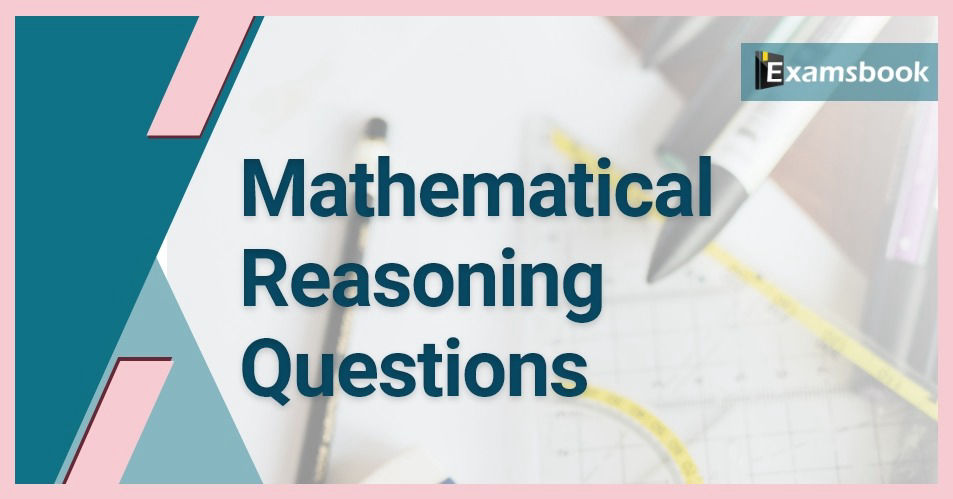


Directions: In the following question assuming the given statements to be true, find which conclusion among the given conclusions is/are definitely true and then give your answers accordingly
Statement:
R ≥ T = Q < M; S ≥ R
Conclusions:
I. M < R
II. S ≥ Q
(A) Only I is True
(B) Only II is True
(C) Either I or II is true
(D) Both conclusions I and II are True
(E) None is True
Directions: In the following question assuming the given statements to be true, find which of the conclusion(s) among given conclusions is/are definitely true and then give your answers accordingly.
Statement: B > C = D ; E < F ; B ≤ A; D ≤ E
Conclusions:
I. A > C
II. B = D
(A) Only conclusion I follows
(B) Only conclusion II follows
(C) Either conclusion I or II follows
(D) Both conclusion I and III follows
(E) None follows
Relationship between different elements is shown in the statements below. These Statements are followed by 2 Conclusions. Mark your answer on the basis of given statements and Conclusions
Statements: A < B ≤ C > D; C > E ≥ F; E > B
Conclusions:
i) A < F
ii) D < B
(A) Only conclusion i) follows
(B) Only conclusion ii) follows
(C) Either conclusion i) or conclusion ii) follows
(D) Both conclusions follow
(E) None Follows
In this question, two statements I and II have been given. These statements may be independent causes or effects of independent causes or a common cause. One of the statements maybe the effect of the other statement. Read both statements and select the correct answer.
I. This year College X reduced the cut-off marks to 50 from 60 for the entrance exam.
II. In the last two years, the Students Union in College X has been actively negotiating with the college administration regarding the Quality of food and Health and Hygiene standards at the College Canteen.
(A) II is the cause and I is its possible effect
(B) I is the cause and II is its possible effect
(C) Both I and II are effects of independent causes
(D) Both I and II are independent causes
In this question, a statement is followed by two courses of action, numbered I and II. You must assume everything in the statement to be true and on the basis of the information given in the statement, decide which course of action/s logically follows for pursuing.
Statement:
A large number of the people of the city are diagnosed to be suffering from Malaria disease.
Course of Action:
I. The city municipal authorities should take immediate steps to carry out extensive fumigation in the city.
II. The people in the area should be advised to take steps to avoid mosquito bites.
(A) Both I and II follow
(B) Only II follows
(C) Only I follows
(D) Neither I nor II follows
Assume following statement is true. On the basis of statement decide which of the courses of action logically follows it.
Statement:
People residing in some tribal areas are far from education.
Courses of action:
I. A mass awareness programme must be initiated in these areas.
II. Social workers should be entrusted to educate them.
(A) Only I follows.
(B) Only II follows.
(C) Both I and II follows.
(D) Neither I nor II follows.
A statement is given below followed by two arguments numbered I and II. You have to decide which of the arguments is a 'strong' argument and which is a 'weak' argument.
Statement:
Should foreign films be banned in India?
Arguments:
I. Yes, they depict an alien culture which adversely affects our values.
II. No, foreign films are of a high artistic standard.
(A) Only I is strong.
(B) Only II is strong.
(C) Both I and II are strong.
(D) Neither I nor II is strong.
A statement is given below followed by two assumptions numbered I and II. You have to decide which of the assumption is implicit in the statement.
Statement:
A warning in a train compartment "To stop train, pull the chain". Penalty for improper use 1000."
Assumptions.
I. Some people misuse the stop chain.
II. On certain occasions, people may want to stop a running train.
(A) If only assumption I is implicit.
(B) If only assumption II is implicit.
(C) If both I and II are implicit.
(D) If neither I nor II is implicit.
Statements:
Some ships are cups.
No cup is a stool.
All windows are cups.
Conclusions:
I. Some ships being windows is a possibility.
II. No window is a stool.
III. All cups are windows.
IV. No ship is a stool.
(A) Only Conclusions I, II and IV follow
(B) Only Conclusions II and III follow
(C) Only Conclusions I and II follow
(D) Only Conclusion I follows
Directions: A statement is given followed by two inferences I and II. You have to consider the statement to be true even if it seems to be at variance with commonly known facts. You have to decide which of the given inferences, if any, follow from the given statement.
Statement I: Classical Indian logicians (Naiyāyikas) define Upamāna (Comparison) as the cognition of the new object through similarity, known by another means of cognition.
Statement II: Naiyāyikas consider upamāna as a type of inductive reasoning and therefore view it as a type of inference (anumāna) only.
(A) Statement I is correct but Statement II is incorrect
(B) Statement I is incorrect but Statement II is correct
(C) Both Statement I and Statement II are correct
(D) Both Statement I and Statement II are incorrect
Get the Examsbook Prep App Today